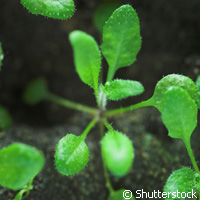Scientists identify protein behind plant's oxygen-sensing mechanism
Regardless of whether you're a botanist or a weekend gardener, you know that too much water can kill your plants. Flooding or water logging of plants doesn't allow them to take up enough of the oxygen required to ensure their cellular respiration and energy production. In order to deal with this state of hypoxia, plants stimulate specific genes. But exactly how plants sense the oxygen concentration has remained a mystery, until now. Researchers in Europe have identified a protein able to bind to certain regions of deoxyribonucleic acid (DNA), thus triggering the transcription of stress response genes. The results, published in the journal Nature, could lead to improving a crop's tolerance of flooding events. A number of recent studies observed how a protein that activates genes so as to respond to hypoxia, a so-called transcription factor, is released from the cell membrane to build up in the nucleus and prompt the expression of stress response genes. Scientists from Germany, Italy and the Netherlands say they have identified a branch of the ubiquitin-dependent N-end rule pathway for protein degradation, which is active in both mammals and plants, function as an oxygen-sensing mechanism in Arabidopsis thaliana, a small flowering plant that is widely used as a model organism in plant biology. The findings show that plants with an overexpression of the RAP2.12 protein have a higher tolerance of submergence and are better able to recover from flooding events. 'When the oxygen concentration is low - as during flooding - RAP2.12 is released from the plasma membrane and accumulates in the nucleus to activate gene expression for hypoxia acclimation.' the authors write in the paper. 'Our discovery of an oxygen-sensing mechanism opens up new possibilities for improving flooding tolerance in crops.' In the spotlight is the role of the N-terminus of the protein (the start of the amino acid chain). A change to this amino acid sequence, whether it is an addition or removal of amino acids, results in the deterioration of a plant's response to low oxygen availability. Normal aerobic conditions facilitate the RAP2.12's attachment to the cell membrane. When oxygen levels drop, the protein detaches from the membrane and accumulates in the nucleus where it can perform its role as a transcription factor and stimulate specific genes. When the oxygen availability increases to normal levels, the RAP2.12 is quickly degraded to stop the transcription of the stress response genes, according to the researchers. They point out that in plants that express an N-terminally modified RAP2.12 the protein is located within the nucleus even before the oxygen stress begins. The modified protein accumulated in the nucleus when hypoxia kicked in, but it was not degraded when the oxygen levels reached normal conditions again. Adding to their discovery is the role of the N-end rule. 'According to the N-end rule, the first amino acid of a protein determines its life span,' says co-author and team leader Joost van Dongen of Max Planck Institute of Molecular Plant Physiology in Germany. 'There are stabilising and destabilising amino acids. Our discovery of RAP2.12 as a central component of the oxygen sensing mechanism in plants opens up interesting possibilities to increase the flooding tolerance in crops.' Around 10% of the world's arable land is subject to temporary flooding every year.For more information, please visit:Max Planck Institute of Molecular Plant Physiology:http://www-en.mpimp-golm.mpg.de/00-news/index.htmlNature:http://www.nature.com/
Countries
Germany, Italy, Netherlands



